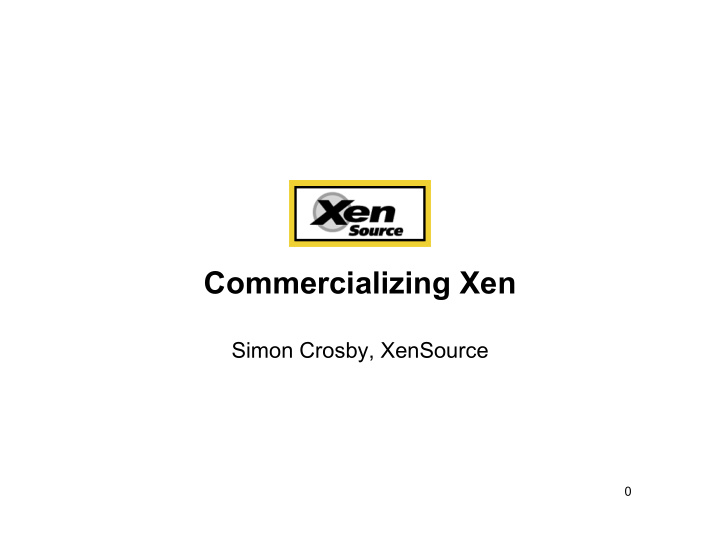



Commercializing Xen Simon Crosby, XenSource 0
Large Market Opportunity “Virtualization is the key enabler for dynamic Service Level Automation.” -IDC Xen plays Source: "Disruptive here Innovation and the Adoption of On- Demand and Utility Computing in the Server Market", IDC, March 2004 1
Virtualization Markets Today VMWare Microsoft Virtual Server Utility computing still largely unaddressed Inadequate performance for large-scale production deployments 2
Xen Can Deliver New Efficiencies Software innovation independent of the hardware Linux XP Solaris High performance, ubiquity-enabled, Xen free hypervisor liberates stack $ Hardware innovation independent of the OS • An Open Source, best of breed Xen frees platform vendors from “Software Jail” • Liberates applications from physical platform dependency • Dramatic savings in OpEx in the enterprise • New opportunities for systems management, software distribution, licensing, fault management etc • Ubiquitous, free hypervisor frees stack $ for all players 3
Commercialization of Xen What do we mean by Commercialization of Xen? Free distribution of Xen Subversion of the Open Source process Continued open, “code rules” development of the world’s best “Proprietary” Xen flavors hypervisor “Copying” Xen in closed source A healthy ecosystem of vendors Virtualization market domination whose solutions are based on Xen by any one player Unequivocal customer benefit A “Xen as an implementation of using Xen, in $ terms a standard” - the code is the Stable interfaces & APIs that standard, standards will evolve enable multiple vendors to compete from our collective work on Xen Stable, high quality, trusted code 4
The Role of Standards • Need to avoid excessive standardization during a fast-moving technology development process • Standards-based interfaces are required, eg for – Managing the hypervisor – Security (authentication etc) – Provisioning of Virtual Machines • But there will be multiple standards eg: WS- MAN/CIM, DMTF, PCI SIG etc, so what is needed first is an open, stable set of APIs • Implementation must precede standardization • Good lessons from attempts to “Standardize Embedded Linux” in the ELC 5
More on Standards • Caveat on APIs - an API is not “the standard” - the code is • A “non Xen” proprietary hypervisor that presents the same “APIs” as Xen is not Xen • Any notion of certifiable “compliance” should include stability, quality, reliability measures • APIs don’t define complex runtime semantics • Standards don’t prevent fragmentation • Any attempt to “standardize a hypervisor” would be overly ambitious - remember “OSF Unix” 6
The Role of XenSource • Lead the Xen Open Source project – Code rules, unbiased selection of best technical solutions – Interface to kernel.org • Host the community – Regular Xen Summits – (future) Xen Users’ Summits; Xen Developer Summits – Host developer site and tools • “One Xen”: build the Xen community, drive toward ubiquity, create the level playing field • Work with the Linux distributions to ensure that Xen meets distro requirements • Work with partners to ensure that Xen is tested and “Commercial Grade” 7
Win-Win with Xen • Xen is the enabler of a new model for enterprise infrastructure • XenSource will be the standard bearer for the drive towards ubiquity of Xen – Xen will always be the best hypervisor – It will always be Open Source – There will be only one Xen • Ubiquitous deployment of Xen will deliver dramatic benefits to all players 8
Speakers Bruce Jones, IBM “IBM’s Plans and Vision for Xen” Tom Christian, HP “Future Standards for Virtual Environments” Simon Crosby, XenSource “Win-win with Xen: Driving to Ubiquity” Q&A and discussion 9
Represented Commercial Interests Infrastructure Software Infrastructure Software System System & Solution Vendors Solution Vendors Platforms & Infrastructure Platforms & Infrastructure * Logos are registered trademarks of their owners 10
Recommend
More recommend